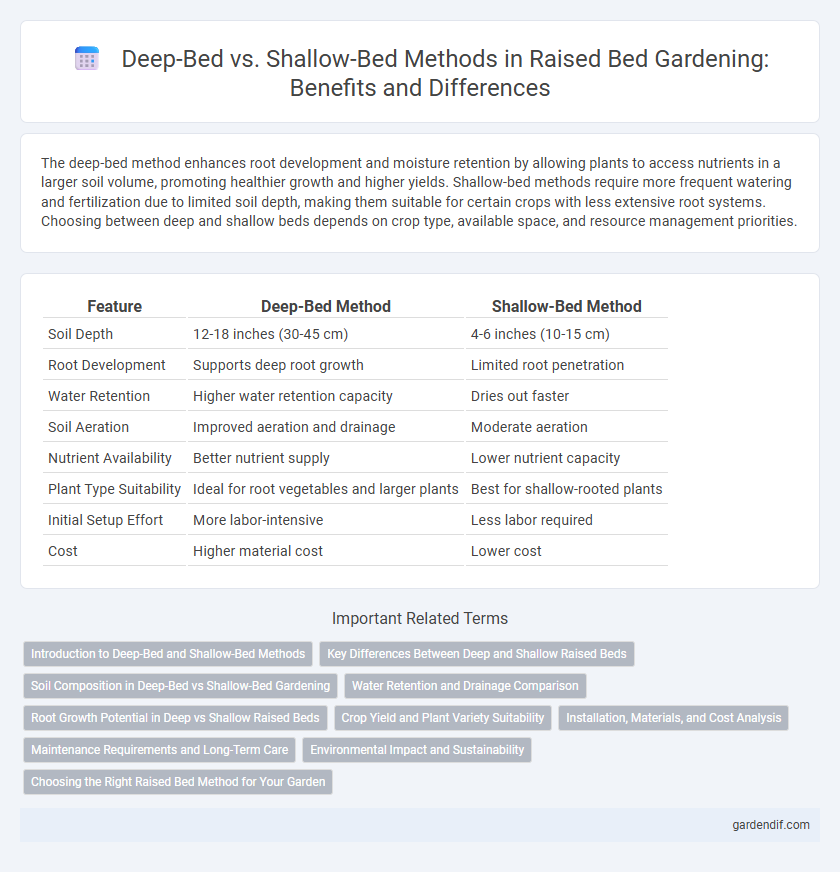
Deep-bed method vs shallow-bed method Illustration
The deep-bed method enhances root development and moisture retention by allowing plants to access nutrients in a larger soil volume, promoting healthier growth and higher yields. Shallow-bed methods require more frequent watering and fertilization due to limited soil depth, making them suitable for certain crops with less extensive root systems. Choosing between deep and shallow beds depends on crop type, available space, and resource management priorities.
Table of Comparison
| Feature | Deep-Bed Method | Shallow-Bed Method |
|---|---|---|
| Soil Depth | 12-18 inches (30-45 cm) | 4-6 inches (10-15 cm) |
| Root Development | Supports deep root growth | Limited root penetration |
| Water Retention | Higher water retention capacity | Dries out faster |
| Soil Aeration | Improved aeration and drainage | Moderate aeration |
| Nutrient Availability | Better nutrient supply | Lower nutrient capacity |
| Plant Type Suitability | Ideal for root vegetables and larger plants | Best for shallow-rooted plants |
| Initial Setup Effort | More labor-intensive | Less labor required |
| Cost | Higher material cost | Lower cost |
Introduction to Deep-Bed and Shallow-Bed Methods
The deep-bed method involves cultivating plants in raised beds filled with nutrient-rich soil extending 12 to 24 inches deep, promoting robust root growth and improved water retention. In contrast, the shallow-bed method utilizes beds with soil depths of 4 to 6 inches, suitable for shallow-rooted crops and allowing quicker soil warming. Both methods optimize space and drainage, but the deep-bed approach supports higher yields due to enhanced soil aeration and nutrient availability.
Key Differences Between Deep and Shallow Raised Beds
The deep-bed method involves creating raised beds that are typically 12 to 36 inches deep, providing ample soil volume for root growth and improved water retention. Shallow raised beds, usually 6 to 8 inches deep, offer better drainage and are easier to manage but may limit plant root development and soil nutrient availability. Key differences include soil depth, root space, moisture control, and suitability for different plant types and gardening goals.
Soil Composition in Deep-Bed vs Shallow-Bed Gardening
The deep-bed method utilizes a richer, more aerated soil composition with higher organic matter, promoting better root development and nutrient retention compared to the shallow-bed method. Shallow beds often contain a more compacted, less nutrient-dense soil layer, limiting water drainage and root depth. Enhanced microbial activity and improved moisture retention in deep beds contribute to healthier plant growth and increased yield potential.
Water Retention and Drainage Comparison
The deep-bed method enhances water retention by allowing a greater volume of soil to hold moisture, promoting prolonged availability for plant roots, while offering superior drainage due to increased soil aeration and reduced compactness. In contrast, the shallow-bed method retains less water and risks quicker drying out, yet may drain faster in sandy or well-textured soils but often lacks the moisture-holding capacity needed in drier conditions. Optimal water management in raised beds depends on balancing depth with soil composition to maximize retention without compromising drainage efficiency.
Root Growth Potential in Deep vs Shallow Raised Beds
Deep-bed method enhances root growth potential by providing greater soil volume, improved aeration, and consistent moisture retention compared to shallow-bed method. Roots in deep raised beds develop more extensively, leading to stronger plant anchorage and increased nutrient uptake. Shallow beds restrict root expansion, often resulting in stunted growth and reduced overall plant health.
Crop Yield and Plant Variety Suitability
The deep-bed method enhances crop yield by promoting stronger root development and improved soil aeration, making it ideal for nutrient-demanding plants such as tomatoes and root vegetables. In contrast, the shallow-bed method suits shallow-rooted plants like lettuce and herbs, offering quicker soil warming but typically resulting in lower overall yields. Selecting the appropriate bed depth directly influences plant variety success and maximizes productivity based on specific crop requirements.
Installation, Materials, and Cost Analysis
The deep-bed method involves installing raised beds with soil depths typically exceeding 12 inches, requiring more organic material such as compost and topsoil, leading to higher upfront costs due to increased material volume and labor intensity. In contrast, the shallow-bed method uses soil depths around 6 inches, minimizing material use and installation effort, which reduces costs but may limit root growth and long-term soil health. Cost analysis reveals that while deep beds incur greater initial expenses, they improve plant productivity and soil structure, potentially offsetting higher installation investments over time.
Maintenance Requirements and Long-Term Care
The deep-bed method requires less frequent soil replacement and provides better nutrient retention, reducing the need for ongoing fertilization and extensive maintenance. In contrast, the shallow-bed method demands more regular soil replenishment and closer monitoring to prevent nutrient depletion and soil compaction. Over time, deep beds promote healthier root systems and improved moisture retention, minimizing long-term care efforts compared to shallow beds.
Environmental Impact and Sustainability
The deep-bed method enhances soil structure and water retention, reducing the need for frequent irrigation and minimizing nutrient runoff, which supports sustainable water use and lowers environmental pollution. In contrast, the shallow-bed method often requires more frequent watering and fertilization, increasing resource consumption and potential runoff that can harm surrounding ecosystems. By promoting healthier root development and soil biodiversity, deep beds contribute to long-term soil fertility and carbon sequestration, making them a more environmentally sustainable choice.
Choosing the Right Raised Bed Method for Your Garden
Deep-bed method enhances soil aeration and nutrient retention, making it ideal for root vegetables and heavy feeders by promoting robust root growth and moisture conservation. Shallow-bed method suits shallow-rooted plants and areas with limited soil depth, enabling quicker soil warming and easier maintenance. Selecting the appropriate raised bed method depends on plant types, soil conditions, and garden goals to optimize yield and plant health.
Deep-bed method vs shallow-bed method Infographic

 gardendif.com
gardendif.com